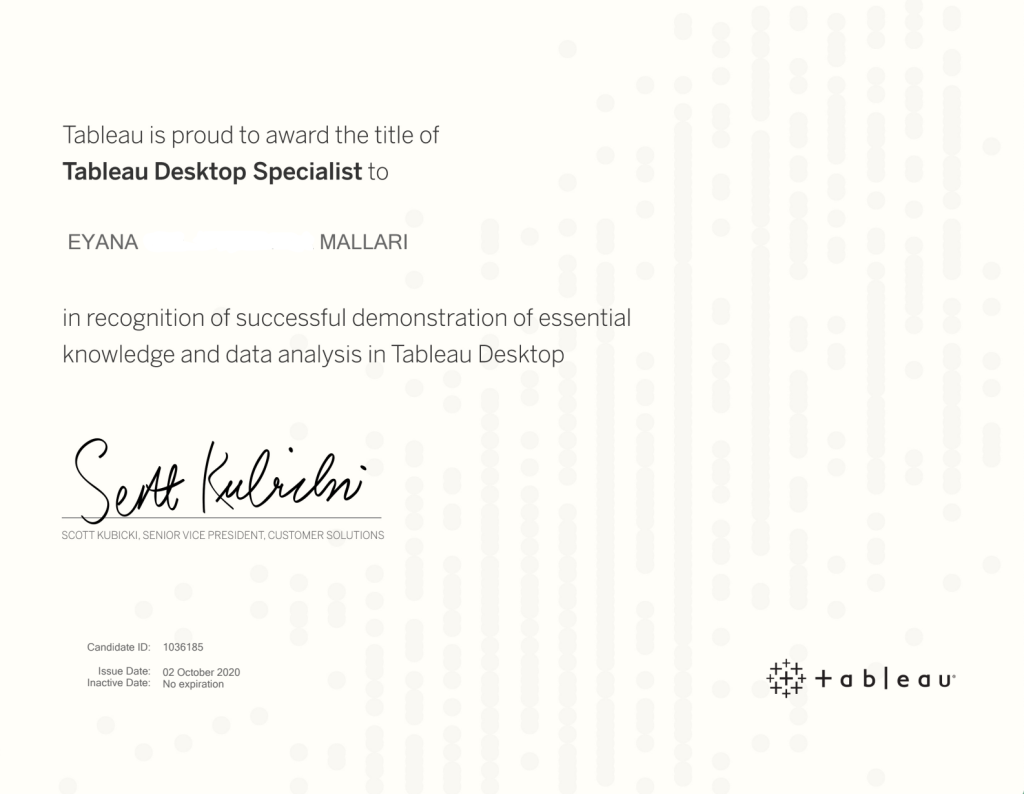The road is long, but I finally passed my Tableau Desktop Specialist certification with flying colors. I encourage anyone working with data to take it. Here are concrete tips that helped me prepare for the exam!
Tip 1: Learn through work experience – ~2 years
I’m the type of person who prefers to start learning with actual practice (and a lot of google searches!). Creating Tableau dashboards has been a day job to me since January 2018. I even attended Tableau Conference 2018 in New Orleans. My focus areas were in sales territory carving, Quote-to-Cash operations and monitoring data hygiene.
One of my favorite analyses I did in Tableau is on sales funnel: At which sales stages do opportunities get stuck or fall off? I cannot show here the exact viz for privacy reasons, but it looked something like this:

Tableau Funnel Chart Tutorial: Click here
If you came from management consulting, chances are you love your powerpoint charts. Try translating those in Tableau! For people like me with software development background, the drag-and-drop interface may take a bit of getting-used-to but you’ll feel spoiled from having no need to code!
To expedite your learning, you’ll also need to know basic concepts in statistics like dimensions and measure, discrete and continuous. Google is your friend!
Tip 2: Take the Designer Learning Path in Tableau eLearning – 2 weeks

Tableau eLearning page (Click image to enlarge)
Fortunately, my company granted us free access to Tableau eLearning, which costs $120 per year. As you can see in the image above, there are many learning paths to choose from. If you particularly want to pass the Desktop Specialist exam, my recommendation is to take the Designer learning path, which covers the following courses:
- Desktop I: Fundamentals – Course Description
- Desktop II: Intermediate – Course Description

Tableau eLearning: Designer path | You’ll only need the Desktop I and Desktop II for the exam 😀 (Click image to enlarge)
I decided to take the full Analyst learning path to have a more comprehensive review, but those two courses I mentioned are more than enough for the exam. I took the Author and Designer learning paths just to have more test questions to practice with.

Tableau eLearning: Analyst path | The other courses are helpful too! (Click image to enlarge)
Make sure to take notes and do the activities diligently to build muscle memory.
Tip 3: Take practice exams!
I’m a firm believer that testing is the most effective way to retain your learning, and to build your confidence. I took the sample quizzes from Learning Tableau. If you want to go further, I highly recommend you to buy the three full practice exams, and take it with a timer. The exams have a similar feel with the actual examination.
Tip 4: Notes on the Exam Day
The examination is proctored, so make sure your internet connection is stable. Follow the instructions in Tableau Desktop Specialist: Exam Setup to avoid technical issues during the exam day.
On the actual exam session, the proctor will check the following:
- You have Google Chrome as a web browser
- Your internet connection is stable. The proctor will request you to run this connectivity test in front of him.
- Only 1 desktop is allowed. Secondary monitors are prohibited.
- No earphones, headsets and other accessories are allowed.
- All other software programs in your computer must be closed.
- Your actual desk is clear of any writing materials.
- You are alone and quiet in your room. The proctor will request you to show him your room in 360 view to double check.
Once those protocols are complete, you will have one hour to complete the exam. I find the exam straightforward, and I had ample time to review my answers.
Results
Once done, you will be able to see your score. Lo and behold, here’s my score:

Couldn’t believe I’m just 2 points away from the perfect score! I’m pleased, but I’m proud to say that I prepared well for this milestone.
By taking this examination, I have proven my Tableau skills, and also conquered my fear of test-taking. Preparing for software certifications like this require both conceptual knowledge and actual practice. Theory and practice build each other.
Practice comes more naturally for me, but learning from 20+ hours of training content enabled me to be more efficient in my work. Tests are positive reinforcement to promote effective learning. – EM


Leave a comment